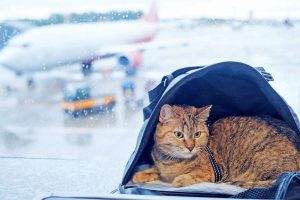Table of Contents
Can You Fly with Your Cat Internationally? Absolutely!
The prospect of international travel with your cat is possible and opens up exciting possibilities. However, each destination has its unique requirements for feline travelers. These may include immunization records, health certificates, and permits to show on a ticket counter. Before takeoff, discuss with your veterinarian and the flight company to understand the necessary documents for international cat travel.Preparation and Planning: The Necessary To-Do List
Check-Up Time with the Veterinarian
Before those paws leave the ground, visiting the vet is crucial. It confirms your cat’s fitness for air travel and provides an opportunity to obtain the health certificate required by airlines and destination countries. Ensure immunization, particularly for rabies, is up-to-date, and take the chance to address any concerns about jet off with your cat.Select a Cat-Friendly Airline
All airlines have their own set of rules and regulations regarding cat or dog travel. Research is critical; identify a flight company that aligns with your and your cat’s needs. Look into cat carrier standards, documentation requirements, and associated pet fees.Make a Reservation for Your Cat
Most flight companies have limitations on the number of pets allowed in the cabin per flight. Once your travel plans are solidified, reserve a spot for your cats and dogs. During the reservation process, be ready to provide details about your cat’s breed, age, weight, luggage, and any special needs.Get the Necessary Paperwork
In addition to the health certificate from your vet, you may need to gather additional documents, such as an import permit or proof of immunization for traveling with a cat for the first time. Double-check the requirements of your destination country and ensure all paperwork is organized well before traveling with pets.
Tips for Flying with a Cat Safely
1. Choose the Perfect Feline Carrier
Choosing a furry friend carrier is paramount whether you’re hitting the road or soaring through the skies. Opt for a cozy, secure, and flight company-approved carrier. Hard-sided carriers are often favored for their durability and easy-to-clean design. Cat owners must ensure the carrier provides enough space to stand, turn around, and lounge comfortably. Soft-sided carriers are also viable, provided they meet flight company requirements and offer ample ventilation.2. Acclimate Your Cat to the Carrier
Reduce pre-flight jitters by getting your cat used to the carrier beforehand. Pop a favorite blanket or toy inside the carrier to make it more inviting. Cat is an emotional support.3. Prepare for Security Screening
Airport security will ask you to take your cat out of its carrier and walk through the X-ray machine with it on a leash. Make this experience smoother by practicing with a leash and harness before your trip. A calming pheromone spray could help your cat relax during the screening.4. Fly in the cabin
Choose to jet off with your cat in the cabin whenever possible, as this is generally safer than the cargo hold. Check with the flight company beforehand, as pet fees and regulations may vary.5. Manage Feeding and Hydration
I usually give my cat a light meal 4 to 6 hours before takeoff on flight day. This helps avoid any upset tummies during the journey. Keep your cat hydrated by offering water before, during, and after the flight.6. Traveling with a Brachycephalic Cat
For some reason, I find bra cephalic cats super adorable. If you own short-skulled cats (a cat with a shortened snout, such as a Persian or Himalayan), you must consult your veterinarian about the risks of flying. Brachycephalic cats can have difficulty breathing, especially in stressful or high altitudes.7. Be Ready for Layovers and Delays
If layovers are part of your journey, or if you’re concerned about possible delays, pack extra food, water, and medication for your cat. Find out where the pet relief areas are in the airports you’ll be visiting, and be ready to give your cat a break if needed.8. Monitor Your Cat’s Comfort
Throughout the flight, watch your cat closely to ensure it’s comfy and not stressed. If your cat seems anxious or uncomfortable, softly reassure it with your voice.9. Ease into Arrival
Once you’ve touched down, give your cat time to adjust to its new environment. Provide food, water, and a litter box as soon as possible, and let your cat explore its new surroundings at its own pace.10. Stick to Your Cat’s Routine
Keeping a similar routine for your cat to the one you had at home can help your feline friend adjust more quickly to the new environment. Maintain consistent feeding times, playtimes, and sleep schedules.11. Be Prepared for Emergencies
Identify emergency veterinary services at your destination before you leave. Keep a copy of your cat’s medical records and your regular vet’s contact info handy.12. Consider a Microchip
A microchip can add extra security in case your cat gets lost or separated from you during your travels. Double-check that your contact info is up-to-date on the microchip registry. Ted from you during your travels. Make sure your contact information is up-to-date on the microchip registry.